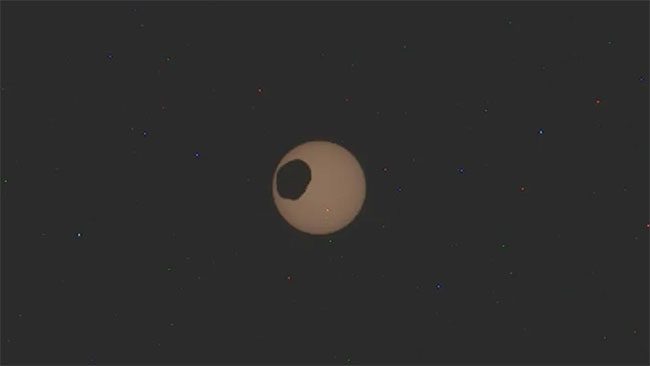Last week, Mars’ moon Phobos passed directly between Mars and the Sun. NASA’s Perseverance rover captured images of this rare solar eclipse.

Phobos passing in front of the Sun as captured by NASA’s Perseverance rover on February 8, 2024. (Image: NASA/JPL-Caltech/ASU)
Phobos, which means “Fear” in ancient Greek, was recorded by the camera on NASA’s Perseverance rover on February 8. The potato-shaped moon could be seen passing in front of the Sun from Percy’s current location in the Jezero crater.
Engineers at NASA’s Jet Propulsion Laboratory (JPL) uploaded 68 images of the solar eclipse to their image archive. The footage was captured using the left Mastcam-Z camera on the rover, one of two imaging devices on the mast commonly used to obtain wide views of Mars.
Discovered by American astronomer Asaph Hall in 1877, Phobos is an asteroid-sized moon that orbits just a few thousand kilometers above Mars’ surface and is gradually spiraling closer to the planet. Eventually, it will break apart due to Mars’ gravitational pull.
Phobos and Mars’ other moon, Deimos, have a mysterious formation history. Scientists are unsure whether they originated from the asteroid belt, from collisions, from leftover debris of the early solar system, or from some other scenario.
No spacecraft has yet reached Phobos, although quite a few probes have flown by over the years. However, the Japan Aerospace Exploration Agency (JAXA) plans to send a Martian Moon Exploration (MMX) mission to Phobos in 2026.
The primary mission of MMX will be to collect dust from the small moon and return particles to Earth. This dust could provide further clues about Phobos’ formation history, as well as Mars’ atmosphere, as gas molecules escape into space and potentially even Phobos itself.
Thus, MMX could help illuminate the mysteries of both Phobos and Mars, as scientists are still trying to understand why Mars lost so much of its atmosphere over millennia.
This research is significant for the potential habitability of Mars, as flowing water requires a certain level of surface pressure. Perseverance’s mission will also be enhanced as it searches for signs of ancient water sources and potentially habitable conditions.
Like MMX, the Perseverance rover also has a sample return mission, but it will need assistance. NASA and the European Space Agency plan to send a Mars Sample Return (MSR) mission to the rover’s location in the 2030s to retrieve samples to bring back to Earth. However, this program faced significant challenges last week when JPL laid off many MSR employees due to budget constraints.
MSR is exceeding its schedule and budget due to its complexity. NASA continues to freeze its spending for 2023 until the U.S. Congress resolves budget issues. NASA lab officials reported that the ongoing uncertainty has led JPL to lay off 8% of its staff this month.


















































